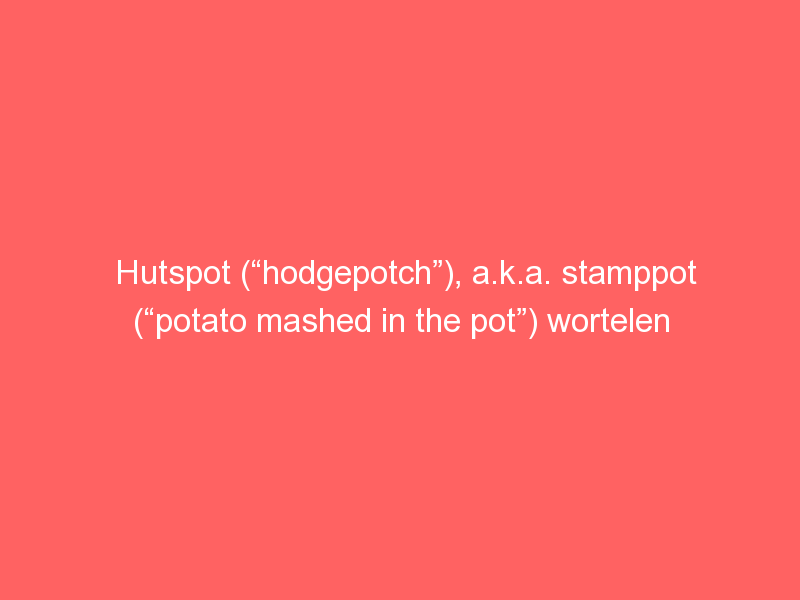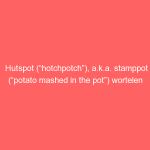Hutspot (“hotchpotch”), a.k.a. stamppot (“potato mashed in the pot”) wortelen (“carrots”)
A deconstructed preparation of a very old traditional Dutch recipe.
Ingredients
- 2 lbs potatoes Yukon Gold, or, even better, for more varied texture, half-and-half Yukon Gold and Ruessets, cut in chunks, skin-on (for waxy potatoes)
- 2 lbs carrots (ideally winter carrots), cut in ⅛" slices, cut in half if they're too thick across, so the sizes are reasonably the same
- 2 lbs onion chopped coarsely
- 1 lbs ground pork coarsely ground
- 6 ea beef brats
- 2 qt beef stock home-made, instant, or storebought
- 1 stick unsalted butter cut in chunks
- koshering salt to taste
- white pepper to taste
Instructions
- Take the (coarse) ground pork and brown it in the frying pan you’ll be using (I like using a cast-iron Dutch Oven, so the flavors of everything – then ground pork, then brats, then onions – all end up in the dish). If not, use some butter, pork fat, ideally bacon grease, if you have it. I brown it quite deeply, add some water, or brandy, to deglaze the pan if it starts to stick, and darken too much to pick up all the flavor.You can use a frying pan (or cast-iron skillet) and a heavy-bottomed stockpot. I prefer a cast-iron Dutch oven, fry in there, while I roast the carrots in the oven, though you can fry them in the pan as well, or a separate skillet to speed up things), and assemble everything in the Dutch oven.Take the ground pork out of the frying pan, using a slotted spoon or something, leaving the pork grease in the frying pan, and put ground pork to the side.
- In the meantime, put the potatoes and brats (I would like to use my own homemade, but Johnsonville Beef Brats or Beef and Onion are just fine), just covered in water, add a bit of salt and cook them until the brats are nice and plump.Take out the brats.Continue cooking the potatoes until you can easily-ish poke a regular fork in them: pour off the liquid (I save it off to the side) and let them sit around in their pot.
- Fry the brats in the pan you used for the ground pork in the pork grease.Again I fry them quite dark, using water or brandy, to deglaze the pan and pick up all the taste.When they’re pretty much done, I add a few tablespoons of butter at a reasonably high temperature, to brown the milk solids in the butter and get a nice dark brown finish to the sausages.I take out the sausages, slice them in thick slices/chunks at a slant (more surface), and return them to the pan, the sliced insides down, flipping them over, to pick up more of the taste of the sausages, and make them richer.Take them out of the pan and put them aside.
- Fry the onions in a frying pan (I love cast iron skillets), with some butter.Sauté them until they’re nicely caramelized (if you have the time you can go all the way for a full caramelization).
- Toss the carrots with some olive oil with salt and white pepper stirred into it until coated.Put them on an aluminum foil-covered heavy cookie sheet and bake until browned.(You can also sauté the carrots in butter – this is a recurring theme in my cooking: I use organic unsalted butter: I love salt, but I cook with unsalted butter so I can control how much and what salt goes in there: I use Diamond kosher salt for bulk stuff, brining and the like, gray sea salt for finishing flavor – until they start to lighten in color and soften.)
- Add the carrots to the onions, mix and fry them together.Add beef stock (your own homemade would be awesome, I use the organic Better Than Bouillon Roasted Beef, make it 50-100% stronger than the recommendation), just enough to cover the onions and carrots.
- Leave the main pot on low heat, stir to make certain it doesn’t stick or burn to the bottom.Mash in the potatoes. I don’t mash all of ’em in at the same time: I do it piecemeal as I like quite a lot of onions/carrots in the hutspot. Traditional hutspot is half or more potatoes. I like the rich veggie taste. I use an old-fashioned wire masher and mash it lightly so it’s quite chunky.At this point, I whip some butter in it to get a smoother, richer, mix (I’ve also fried lardons to add to the mixture and whipped in the bacon grease).
- Add the ground pork, stirring in the dish, mixing it in thoroughly.Add the pieces of brats, stirring them into the dish.
- Serve possibly drizzled with bacon grease, browned butter, or a chunk of butter, and some white pepper.Letting it stand overnight in the fridge, then fry up with some butter to get a crust on it is nice (also works for leftovers).Served on roggebrood (Dutch ryebread) (the recipe's on this site) is traditional and just about perfect.
Notes
Historically it is celebrated every October 3rd in Leiden to celebrate its breaking of the siege by the Spanish. Legend has it that after the long siege, the Dutch found the Spanish camps with some beef, potatoes, carrots, and onions, and cooked them all together in a single pot.
Traditionally it is made by boiling potatoes, carrots, onions, and klapstuk (a beef cut from the ribs, heavily marbled) all together. I think preparing the ingredients separately works much better and lets you bring out the best of each.

